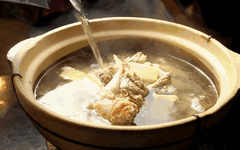During the Spring Festival, every day is filled with lavish meals, and a hearty soup is always needed to complement them.
Drinking soup during the New Year is not only about taste but also about nourishing the body with auspicious soups.
During the Spring Festival, it is inevitable to indulge in feasting while visiting relatives and friends, leading to an increased burden on the digestive system. Although it is a time of great culinary enjoyment, the body can feel overwhelmed. It is advisable to prepare some soups that help relieve stagnation, eliminate greasiness, and clear heat to timely adjust the body’s condition.
The “Spring Festival” is a traditional festival of the Chinese nation, where families gather for reunion dinners. The family cook strives to create an unforgettable and delicious New Year’s Eve dinner. Today, I will introduce a soup that can rival those served in restaurants.
Considering that there are many family members during the festival, both young and old, the prepared soup should have a balanced flavor and be delicious.
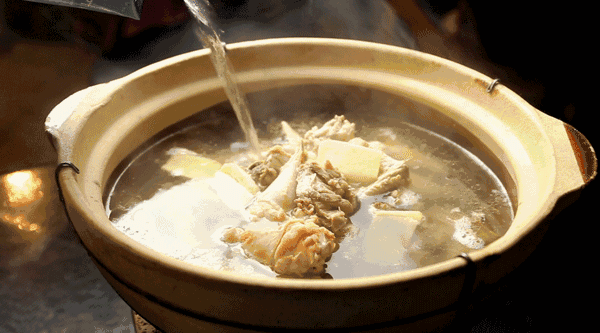
Drinking soup during the New Year brings good fortune
Wishing you success in all your endeavors Cordyceps Chicken Soup with Goji Berries
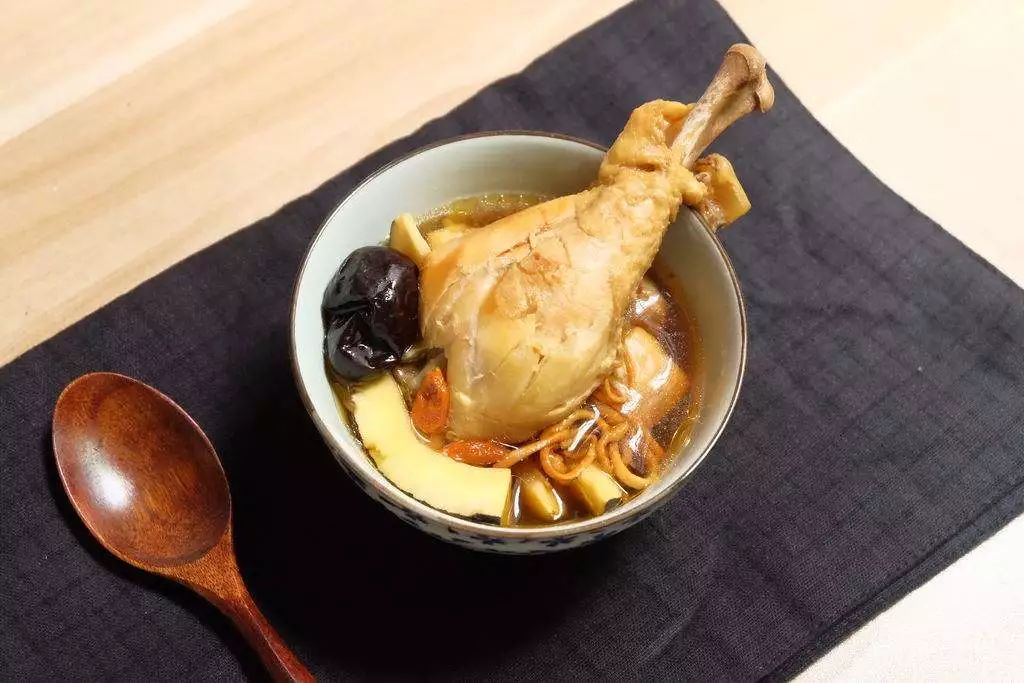
Main Effects: Nourishes the kidneys, moistens the lungs, nourishes yin, and replenishes blood.
Recommended for: Individuals with kidney deficiency, cough, and night sweats.
Ingredients: 20g Cordyceps (Chongcao), 10g Goji Berries (Gouqi), half a black chicken (serves 3).
Preparation: Clean the Cordyceps and Goji Berries, clean and skin the black chicken, cut it into pieces and blanch in water. Place all ingredients in a stewing pot, add 1000ml of water, and stew for about 1.5 hours. Season with salt to taste before serving.
Effect Explanation: Cordyceps, also known as “Earthworm Grass” or “Cordyceps Sinensis,” can be used in soups, stir-fried, deep-fried, or cold dishes, with a sweet flavor. This herb is mild, slightly sweet, and neutral, entering the lung and kidney meridians. It has effects such as nourishing the kidneys, moistening the lungs, nourishing yin, replenishing blood, activating blood circulation, and clearing heat. It is commonly used in folk medicine to treat cough, irritability, night sweats, and injuries. Goji Berries are added to enhance the nourishing effect and add a festive color. It is recommended to skin the black chicken, as leaving the skin makes the soup too greasy. Since we tend to eat more during the New Year, a lighter soup is more suitable.
Five Blessings Arrive Matsutake, Longan, Bamboo Fungus, and Red Date Chicken Soup
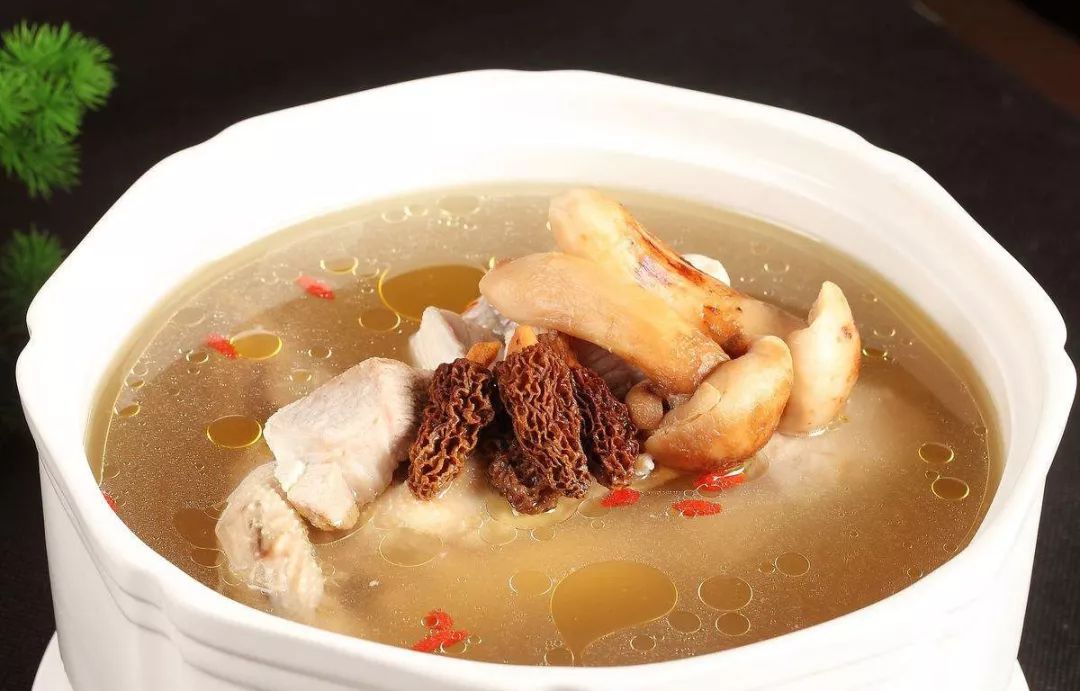
Main Effects: Anti-fatigue, regulates immunity.
Recommended for: Those who stay up late during the New Year and are prone to colds.
Ingredients: 12-16 dried Matsutake mushrooms, 30g Longan (Longan), 10g dried Bamboo Fungus (Zhuzhong), 6 large red dates (about 40g), 2 chicken carcasses, 100g lean meat (serves 6-8).
Preparation: Clean the dried Matsutake, soak in warm water for about 3 hours, clean the Longan, Bamboo Fungus, and red dates. Clean and cut the chicken carcasses into pieces and blanch in water. Place everything in a clay pot, add 4000ml of water, and simmer for about 1-1.5 hours. Season with salt to taste before serving.
Effect Explanation: Matsutake and Bamboo Fungus are both mushroom ingredients, making the soup particularly delicious. They are rich in polysaccharides, which have anti-fatigue and immune-regulating effects. This soup is perfect for those who often stay up late during the New Year, helping to restore energy. Importantly, all these ingredients are food items with very mild properties, making it safe for all ages to consume. The choice of chicken carcasses aims to minimize fat from the chicken meat, ensuring the soup remains clear and does not overpower the Matsutake’s flavor.
(During the New Year, only dried Matsutake is available; fresh ones can only be found in July-August, but this does not affect their deliciousness. This precious ingredient is best enjoyed together with family during the New Year.)
Step by Step Ascension Shiitake Mushroom, Bamboo Shoot, Dried Scallop, and Sea Cucumber Soup
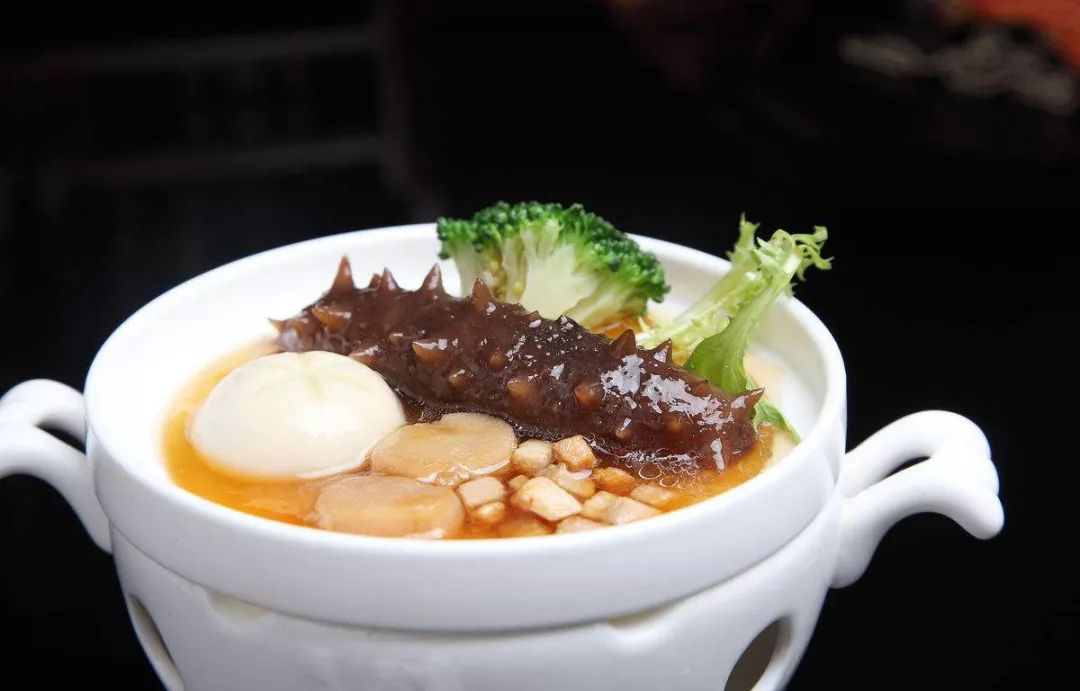
Main Effects: Nourishes the spleen and stomach, anti-cancer.
Recommended for: Suitable for family gatherings (those with high uric acid should eat less).
Ingredients: 25g dried Shiitake mushrooms, 150g bamboo shoots, 50g dried scallops (Yaozhou), 5 sea cucumbers, 1 chicken carcass, ginger, and cooking wine to taste (serves 5-6).
Preparation: Soak the Shiitake mushrooms in warm water until soft, slice the bamboo shoots and blanch them, soak the sea cucumbers in warm water until soft (soak in 40-degree water, cut open, remove the internal organs, wash, and boil in water for about 30 minutes, then soak in cold water until soft, changing the water frequently to avoid oiliness). Cut the chicken carcass into pieces and blanch. In a clay pot, add 2.5-3L of water, place all ingredients inside, bring to a boil over high heat, then simmer for 1-1.5 hours, adding a little cooking wine for flavor before serving.
Effect Explanation:
-
Shiitake mushrooms have the effect of nourishing the intestines and stomach, and anti-cancer properties, useful for gastrointestinal inflammation, ulcers, and cancer;
-
Bamboo shoots have a fresh taste and are high in fiber (100g of spring bamboo shoots contain as much fiber as 50g of oats), making them a good dish for preventing constipation. However, those with poor digestive function should eat less (drink the soup without the bamboo shoots);
-
Dried scallops and sea cucumbers are seafood rich in high protein. Although they are not everyday foods, they offer a unique flavor when consumed occasionally. Modern pharmacological studies show that sea cucumbers have anti-tumor effects and are low in purines, making them suitable for those with high uric acid. However, since the soup contains scallops and chicken, which are rich in uric acid, those with high uric acid should limit their intake.
If you experience a cough with a small amount of yellow phlegm, accompanied by symptoms of sore throat, nasal congestion with yellow discharge, headache, red eyes, dry mouth, and yellow urine, you may try drinking this soup.
Everlasting Youth Peach Gum Nourishing Soup
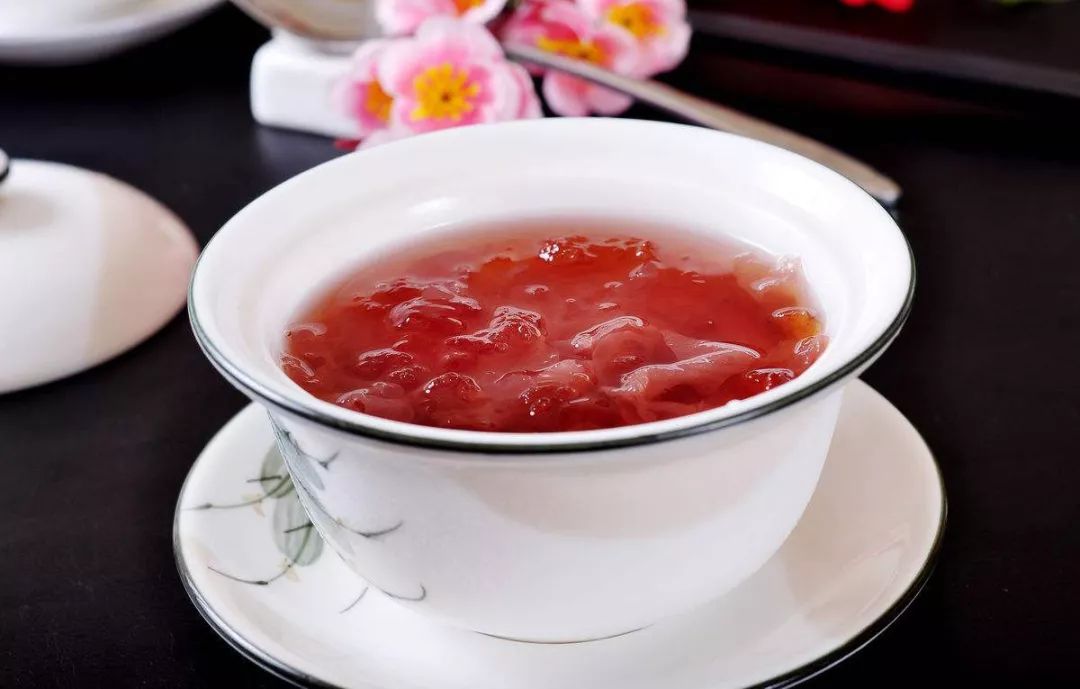
Main Effects: Nourishes yin, moistens dryness, and promotes bowel movement.
Recommended for: Those feeling dryness in the mouth and nose, throat dryness, and skin dryness.
Ingredients: 5g Peach Gum (Taogao), 10g Solomon’s Seal (Yuzhu), 10g dried Lily Bulbs (Baihe), 3 red dates, 3g Goji Berries, 150g lean meat (serves 2-3).
Preparation: Soak the Peach Gum for 4-6 hours until expanded; rinse the herbs slightly; clean and blanch the lean meat, cut into small pieces; place all ingredients in a large stewing pot, add water to 8-9 parts full, and simmer on low heat for 45-60 minutes, seasoning with salt to taste.
Effect Explanation: This soup combines Peach Gum with Solomon’s Seal, Lily Bulbs, red dates, and Goji Berries, making it effective for nourishing yin and moistening dryness. It is suitable for symptoms of dry skin, dry mouth and nose, and constipation during winter. According to TCM health theory, “nourishing yin in autumn and winter” is essential, and this soup fits perfectly.
The five medicinal soups introduced above are very suitable for consumption during the Spring Festival when gathering with friends and family, not only nourishing the body but also being delicious and nutritious.
One Medicinal Soup Every Day from the Spring Festival to the Lantern Festival
Pork Stomach and Goji Chicken Soup

Ingredients: One pork stomach, half a chicken, 10g Goji Berries, appropriate slices of ginger, about 10 peppercorns, one green onion, salt to taste, flour as needed, cooking wine as needed.
Preparation:
-
1. Clean the pork stomach and chicken, place the chicken inside the pork stomach with green onion and ginger slices, blanch in water, then rinse with cold water to remove any scum.
-
2. Place the blanched pork stomach and chicken in a pot with 6 slices of ginger and 10 peppercorns, add water, and boil.
-
3. Add a piece of green onion, boil for half an hour, then simmer for 2 hours, adding salt to taste.
-
4. After two and a half hours, insert a chopstick into the pork stomach; if it pierces easily, remove the pork stomach and chicken.
-
5. Cut the pork stomach into strips, shred the chicken, and return them to the pot to simmer for another 10 minutes, adding a few Goji Berries before serving.
Main Effects: This soup is beneficial for those with insufficient energy, poor appetite, indigestion, coldness, stomach pain, and alcohol-induced stomach damage. It has effects of promoting qi, strengthening the spleen, warming the stomach, nourishing the stomach, dispelling cold, alleviating stomach pain, and detoxifying.
Radish and Pork Rib Soup
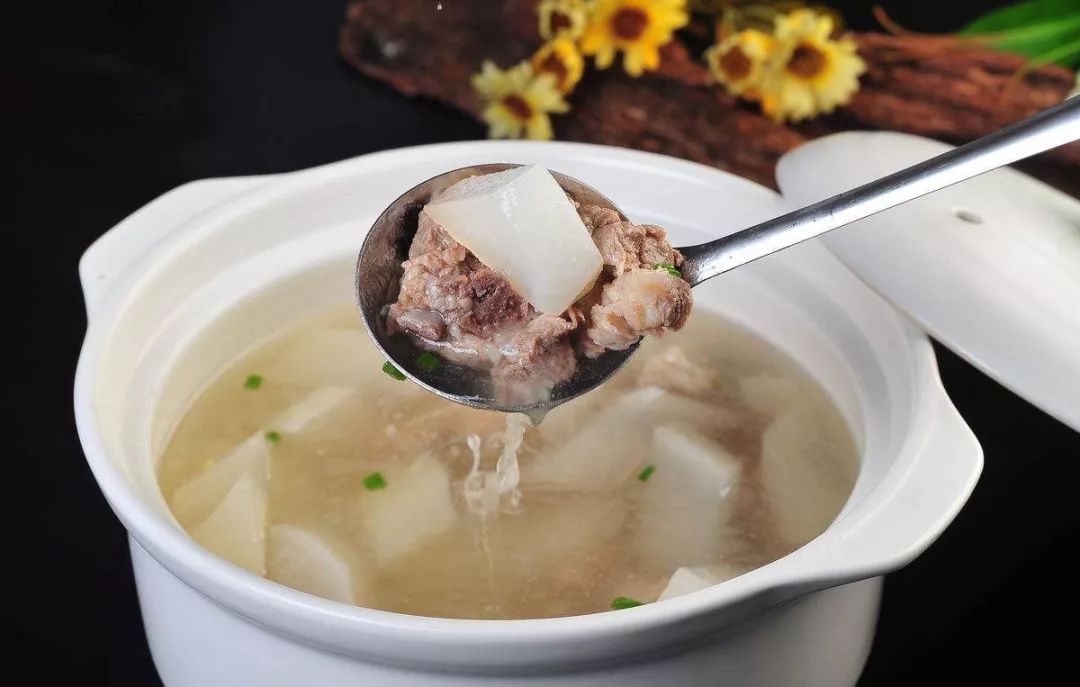
Ingredients: White radish, pork ribs, ginger slices, star anise, green onion.
Preparation:
-
1. Cut the radish into slices about three centimeters thick; blanch the pork ribs in boiling water, then rinse with cold water to remove oil and blood.
-
2. In a soup pot, add water, place the pork ribs in cold water, add ginger slices, star anise, and a little cooking wine, and cook in a pressure cooker for 20 minutes.
-
3. Pour into a soup pot, remove any scum, and add the radish; after 20 minutes, add salt and serve.
Main Effects: Radish has effects of aiding digestion, relieving bloating, detoxifying, and stopping bleeding. Radish is rich in vitamin C, carotene, and rough fiber, making it effective for lowering blood lipids, stabilizing blood pressure, and preventing and treating gallstones. Pork ribs are sweet and neutral, nourishing weakness and strengthening bones. When stewed with radish, the soup is fragrant and fresh, not greasy, and has a good effect of relieving greasiness.
Angelica and Red Date Lamb Soup
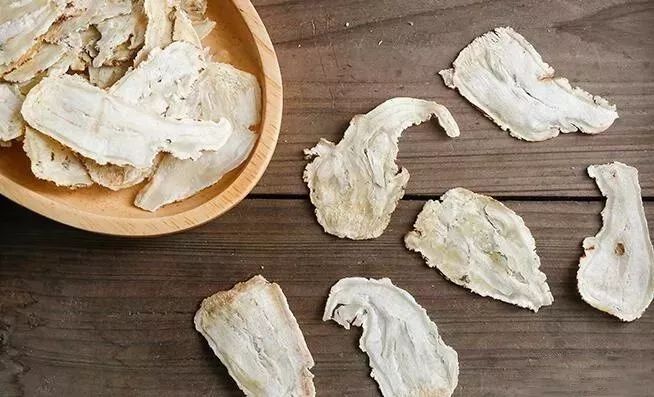
Ingredients: 500g lamb, 20g Angelica (Danggui), 20g red dates, 10g longan, 10g Goji Berries, and ginger to taste.
Preparation:
1. Clean the lamb, cut into pieces, blanch in boiling water, skim off the scum, and set aside.
2. Peel the ginger, pit the red dates, and rinse the Angelica, longan, and Goji Berries.
3. Place all prepared ingredients in a soup pot, add an appropriate amount of water, bring to a boil, then simmer on low heat for 1.5-2 hours.
Main Effects: The “Angelica and Red Date Lamb Soup” formula comes from the ancient medical sage Zhang Zhongjing’s “Jinkui Yaolue”. After flavor adjustments, it includes premium lamb, Angelica, red dates, ginger, and other main ingredients, providing warming benefits to the heart and kidneys, strengthening the spleen and stomach, nourishing qi and blood, and strengthening the body. It is an excellent choice for winter nourishment.
Lotus Root and Duck Soup
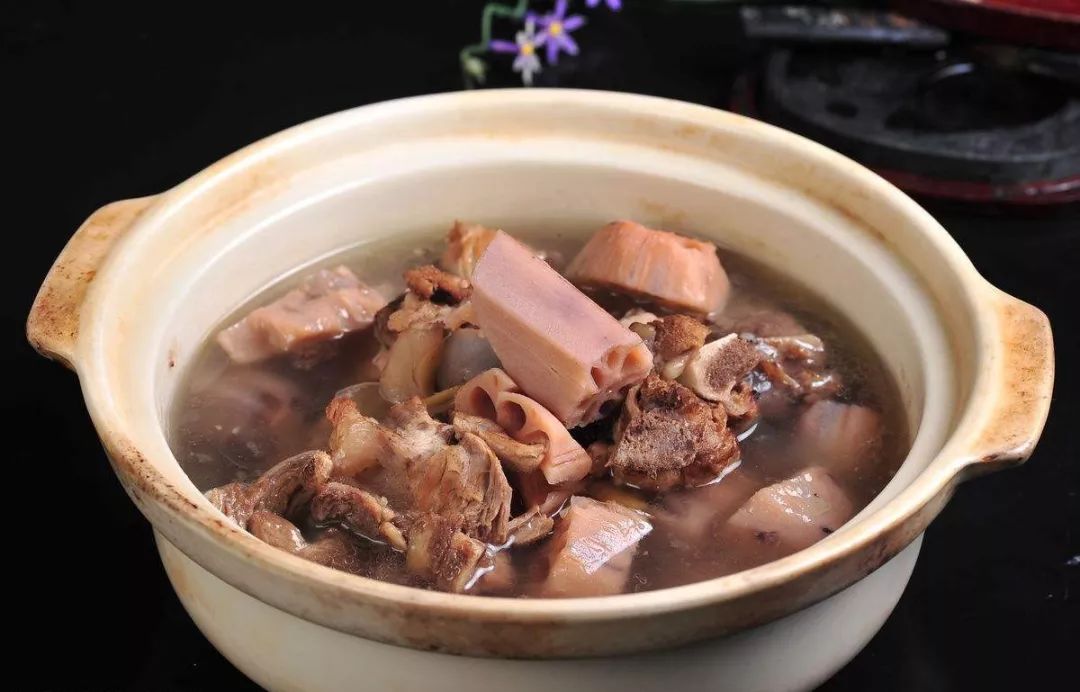
Ingredients: 2 lotus roots (about 500g), 500g duck carcass, ginger (6 slices), and 2000ml of water.
Preparation:
-
1. Cut the duck carcass into pieces and wash clean, peel and cut the lotus root into chunks, and wash and slice the ginger.
-
2. In a pot, add water, bring to a boil, and blanch the duck carcass for 3 minutes, then rinse with clean water to remove surface scum.
-
3. Place the duck carcass in a soup pot, add enough water, cover, and bring to a boil. When it is close to boiling, uncover and skim off the scum. Add ginger slices, cover, and simmer on medium-low heat for 30 minutes.
-
4. Add the lotus root chunks, cover, and continue to simmer on medium-low heat for 1.5 hours. Season with salt before serving.
Main Effects: This soup can clear heat, eliminate phlegm, nourish blood, and beautify the skin. It is suitable for those with anemia, palpitations, and insomnia. Additionally, it has effects of nourishing the kidneys, replenishing blood, moistening dryness, strengthening the gastric mucosa, preventing anemia, improving digestion, and stopping bleeding.
Huangqi Black Chicken Soup
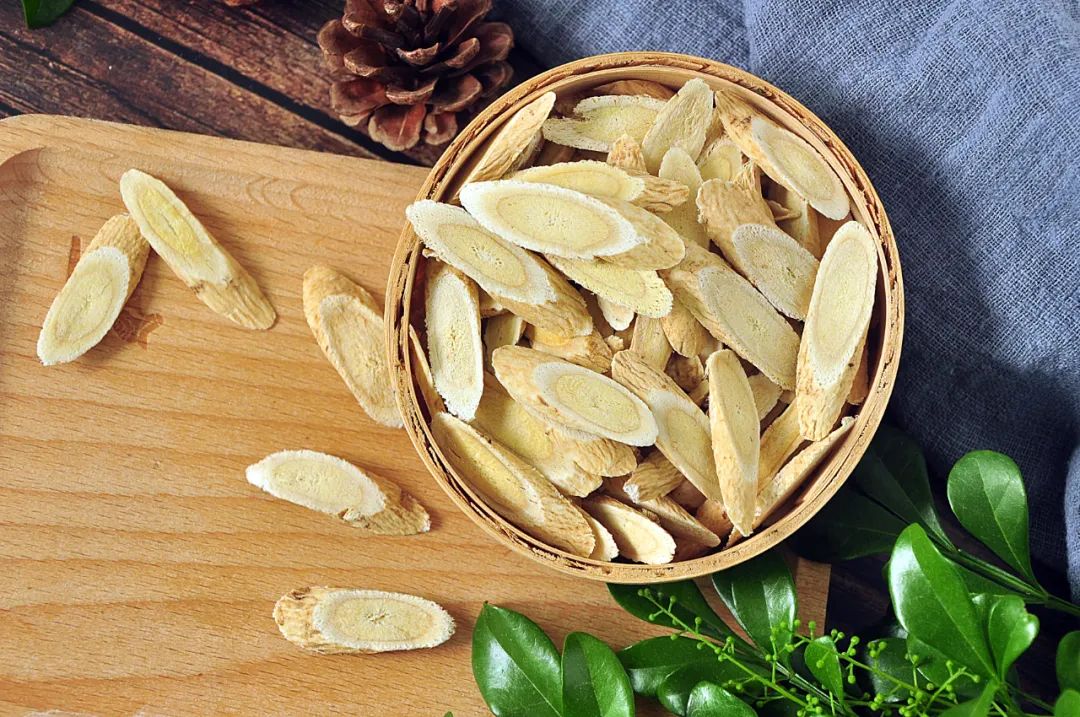
Ingredients: One black chicken, 10g red dates, 30g Huangqi (Astragalus), 10g Angelica, appropriate amount of Job’s Tears, and a little salt.
Preparation:
1. Rinse the red dates, Huangqi, Angelica, and Job’s Tears, soaking for about 20 minutes;
2. Clean and cut the black chicken into pieces, blanch in water;
3. Place the chicken pieces and herbs in a pot, add an appropriate amount of water, bring to a boil, then simmer on low heat for about two hours;
Main Effects: This soup nourishes both qi and blood, strengthens the kidneys, and regulates essence. It is suitable for those with menstrual disorders, qi and blood deficiency, kidney deficiency, irregular menstruation, light menstrual flow, fatigue, shortness of breath, dreams, insomnia, dizziness, pale complexion, etc. Huangqi is known for its qi-nourishing and strengthening effects on the spleen and stomach, suitable for those with weak spleen qi, fatigue, poor appetite, and loose stools. Modern studies show that Huangqi contains various antibacterial components that enhance immune function, preventing infectious diseases. Additionally, it can enhance cellular metabolism, providing anti-fatigue, anti-aging, anti-radiation, and liver protection effects.
Yam and Poria Dove Soup
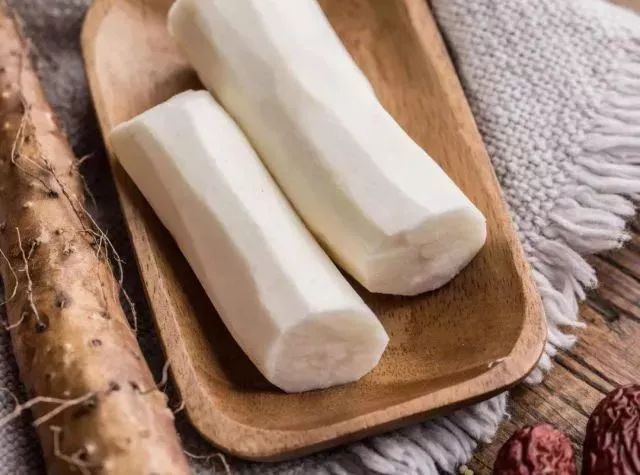
Ingredients: One dove, 400g yam, a handful of Goji Berries, and a large piece of ginger.
Preparation:
-
1. Peel and slice the yam, clean the dove and cut into 4 pieces, rinse the Goji Berries, and crush the ginger.
-
2. Place all ingredients in a soup pot, add an appropriate amount of water, bring to a boil, and skim off any scum.
-
3. Simmer on medium-low heat for 1.5 hours, seasoning with salt to taste.
Main Effects: This soup has the effect of strengthening the spleen and replenishing qi and blood. It can treat symptoms of spleen and stomach deficiency, qi and blood deficiency, such as poor appetite, fatigue, dizziness, pale complexion, and white lips, or patients with anemia and insomnia.
Yam Chicken Soup
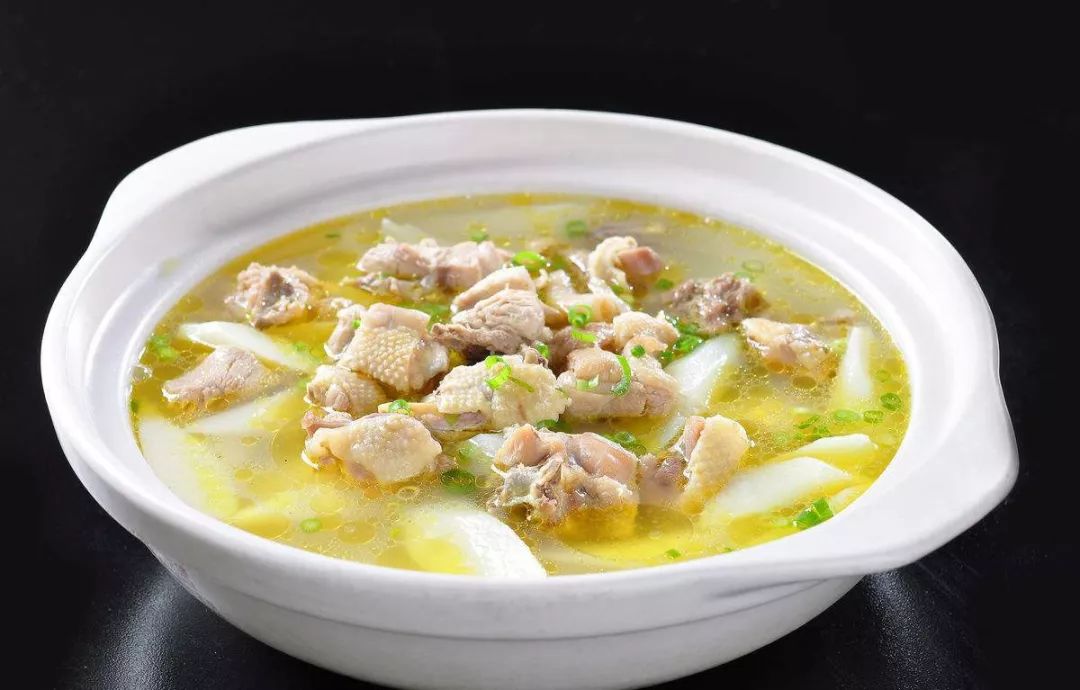
Ingredients: 250g yam, half a chicken, 200g shiitake mushrooms, 3 honey dates, salt, ginger to taste, and 5 red dates.
Preparation:
-
1. Cut the chicken into small pieces, cut the yam into chunks, and slice the ginger;
-
2. Heat oil in a pot, add ginger slices to sauté until fragrant, then add chicken pieces and stir-fry until they change color and release aroma, slightly browning the skin. Transfer to a slow cooker, add an appropriate amount of water, and add yam, simmering on low heat for 2 hours;
-
3. Add shiitake mushrooms, honey dates, and red dates, continuing to simmer for another twenty minutes. Finally, add salt to taste before serving.
Main Effects: This soup has effects of strengthening the spleen, nourishing the stomach, replenishing the lungs, benefiting the kidneys, replenishing deficiency, and dispelling evil. It is suitable for treating symptoms of spleen deficiency, diarrhea, chronic dysentery, deficiency cough, nocturnal emissions, frequent urination, etc. The yam chicken soup also has beautifying effects, making it a good choice for women who care about their appearance. However, it should not be consumed excessively, as it may trigger old ailments.
Lotus Root and Old Duck Soup
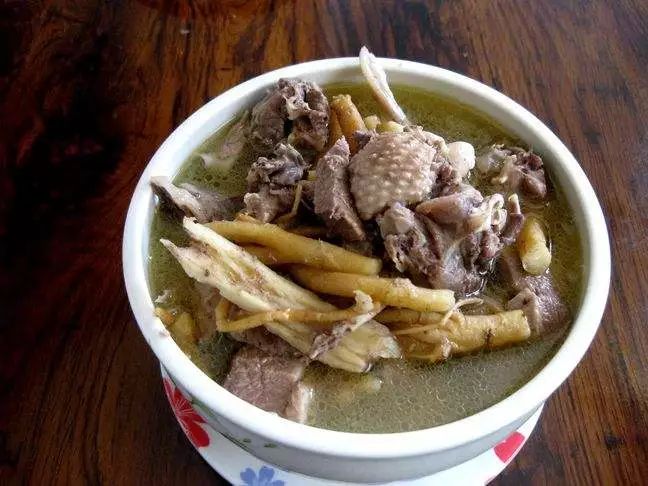
Ingredients: Old duck, lotus root, ginger, green onion, red dates, and salt.
Preparation: Cut the old duck into pieces, cut the lotus root into large chunks, and cook with the blanched old duck in a pot. Add water, bring to a boil, and simmer on low heat for 2 hours, seasoning with salt to taste.
Main Effects: Lotus root can strengthen the spleen and benefit the stomach. Eating more lotus root can help clear accumulated blood in the abdomen and promote milk secretion in postpartum women. Lotus root soup has cough-relieving effects, and drinking juice made from fresh lotus root can treat severe cough.
Golden Mushroom and Clam Soup
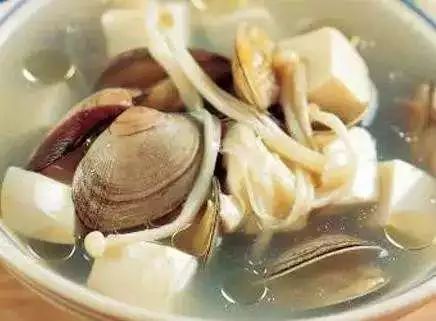
Ingredients: 100g Enoki mushrooms, 200g clams.
Preparation:
-
1. Clean the Enoki mushrooms, removing the roots, and blanch in salt water before setting aside; clean and slice the ginger;
-
2. Pour broth into a pot, add the clams after they have expelled sand, and add tofu cut into pieces to cook. Then add the Enoki mushrooms and ginger slices;
-
3. Once the clam shells open, season with salt, turn off the heat, and sprinkle with pepper.
-
4. Soak the rice and beans together in water, ensuring the water level is 5cm above the rice;
-
5. Bring to a boil over high heat, then reduce to low heat until the grains are soft. After cooling slightly, add honey to taste.
Yam, Goji, and Carp Soup
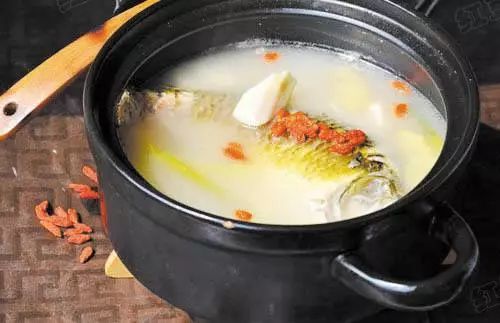
Ingredients: 1 carp, 20 Goji Berries, 250g yam, salt to taste, green onion and ginger to taste, 5ml white wine, and pepper to taste.
Preparation:
-
1. Clean the carp, rubbing a little salt on the fish body.
-
2. In a frying pan, add olive oil. Place the carp in and fry until both sides are slightly yellow. In a clay pot, bring water to a boil. Add the fried carp and green onion.
-
3. Add white wine, then add the peeled and cut yam. Cover and boil for 20 minutes. Soak the Goji Berries in clean water.
-
4. Once the fish soup turns milky white, add salt and pepper to taste. Finally, add the Goji Berries and turn off the heat.
Main Effects: Yam has nourishing and strengthening effects, aids digestion, stops sweating, and alleviates diarrhea. It is used for treating spleen deficiency diarrhea, lung deficiency cough, diabetes, frequent urination, nocturnal emissions, women’s discharge, and chronic enteritis with poor digestion. Goji Berries are classified by the Ministry of Health as a “dual-purpose” food, and they can be processed into various foods, beverages, health wines, and health products. They are often added to soups or porridge. Carp has effects of strengthening the spleen and stomach, promoting diuresis, and improving blood circulation, making it a good dietary choice for those with weak spleen and stomach, poor appetite, edema, and stomach pain.
Corn, Chestnut, and Pork Rib Soup

Ingredients: 400g pork ribs, more than 10 chestnuts, 1 sweet corn, Goji Berries, cooking wine, salt, and ginger slices (to taste).
Preparation:
-
1. Cut the corn into pieces and peel the chestnuts;
-
2. In a pot, add half a pot of clean water, add the cleaned pork ribs, and bring to a boil. At this time, a layer of foam will appear on the surface, which is the blood water. Turn off the heat, remove the pork ribs, and wash clean;
-
3. In a clay pot, add enough water (do not add water midway), add the pork ribs, corn pieces, chestnuts, ginger, and cooking wine, bring to a boil, then reduce to low heat;
-
4. Simmer for two hours, adding Goji Berries and salt to taste before serving.
Main Effects: Pork ribs are rich in calcium and phospholipids, and with the help of vitamin D from corn, we can better absorb the calcium in the pork ribs. Corn is also rich in components that lower blood pressure, and pork ribs are lean meat with low fat content. Therefore, consuming corn and pork rib soup not only nourishes the body but also helps lower blood pressure and blood lipids. Studies show that regular consumption of corn can effectively prevent high blood pressure and high blood lipids, providing good health benefits for cardiovascular health.
Fish Head and Tofu Soup
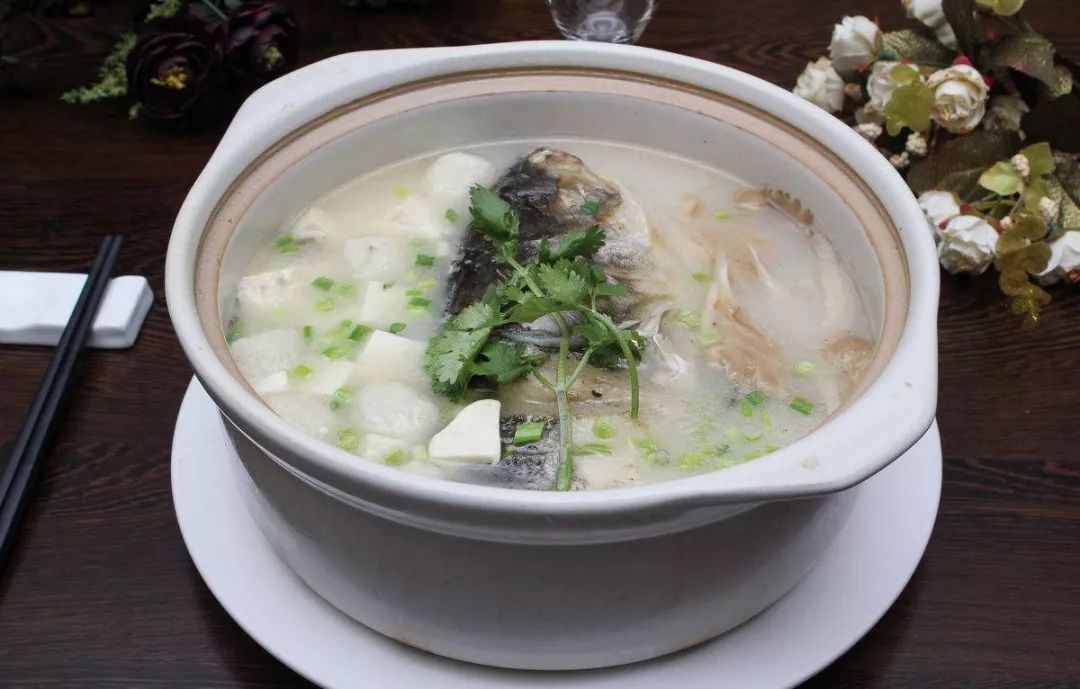
Ingredients: 1 fish head (about 500g), 1 box of soft tofu, 8 shiitake mushrooms, 3 segments of green onion, 3 slices of ginger, and salt to taste.
Preparation:
-
1. Clean the fish head, cut it in half, and dry the surface moisture with a paper towel. Cut the soft tofu into 1cm thick pieces. Soak the shiitake mushrooms in warm water for 5 minutes, then remove the stems and wash clean.
-
2. In a frying pan, add oil, and when it is 70% hot, add the fish head and fry until golden brown on both sides (about 3 minutes each side). Place the fish head to one side of the pan, and use the oil in the pan to sauté the green onion segments and ginger slices, then pour in enough boiling water to cover the fish head.
-
3. Add the shiitake mushrooms, cover, and simmer for 50 minutes.
-
4. Season with salt, add the tofu, and continue to cook for 3 minutes before serving.
Main Effects: The fish head is rich in gelatinous protein, with low fat and calories, providing benefits for strengthening the spleen, replenishing qi, warming the stomach, and beautifying the skin. Tofu is rich in protein and calcium, with effects of clearing heat, moistening dryness, generating fluids, and detoxifying, as well as lowering blood lipids. Drinking the fish head and tofu soup not only warms the body and nourishes the brain but also helps keep the skin smooth and delicate.
Yam and Goji Rib Soup
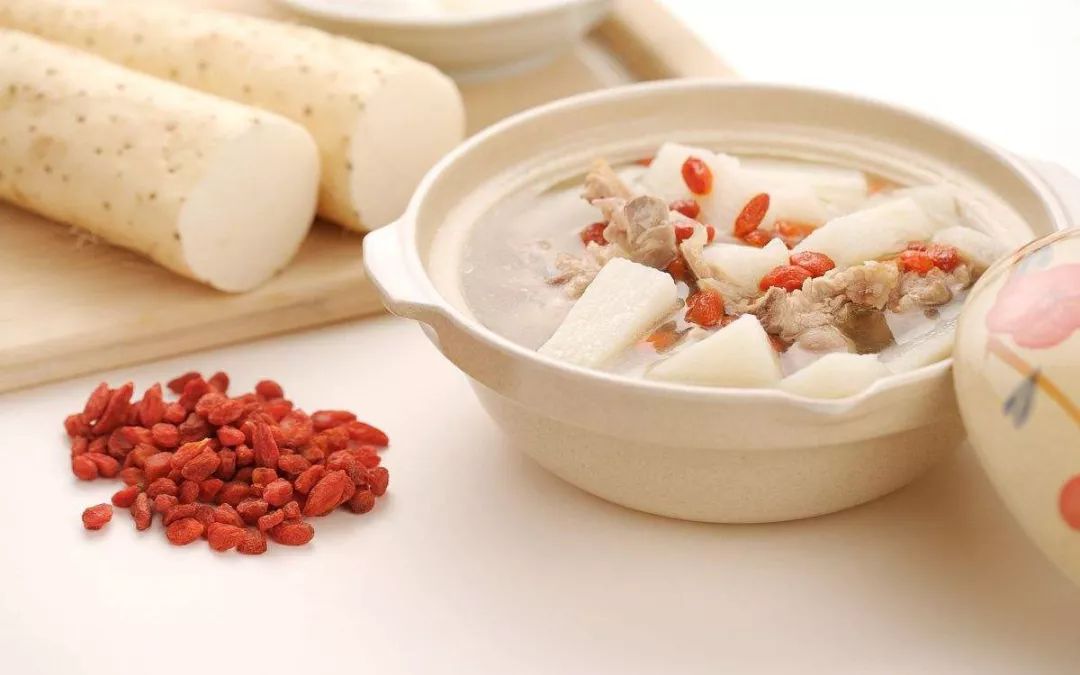
Ingredients: Yam, pork ribs, green onion, ginger, and Goji Berries.
Preparation: Blanch the pork ribs, rinse off the scum, then place in a pot. Add green onion, ginger, yam, and other ingredients, and simmer on low heat for 2 hours.
Main Effects: Yam and Goji Rib Soup is light and not greasy, making it suitable for the whole family. It has effects of clearing heat, solidifying the stomach, and strengthening the spleen and stomach, especially suitable for the elderly and children.
Yam is mild in nature, with functions of moistening the lungs, strengthening the spleen, and benefiting the kidneys. It contains amylase, polyphenol oxidase, and other substances that aid in digestion and absorption, making it a dual-purpose food for nourishing the spleen and stomach. Yam is also rich in various nutrients, strengthening the body and nourishing essence.
Goji Berries clear the liver and improve eyesight, supporting the body’s functions and promoting health recovery, while enhancing the body’s resistance to disease and harmful stimuli.
White Radish, Kelp, and Pork Rib Soup
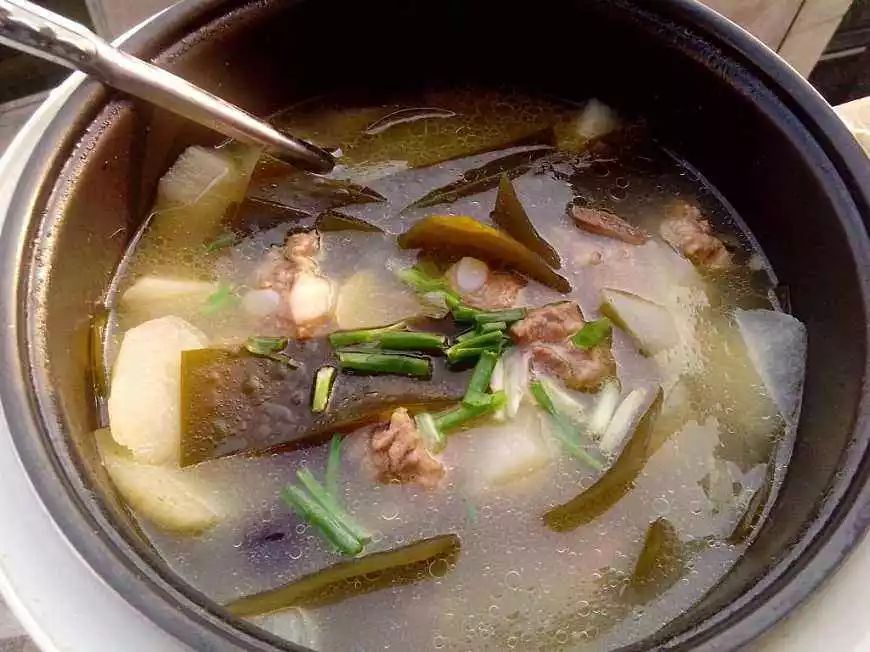
Ingredients: One white radish, 400g pork ribs, kelp (to taste), salt (to taste), one green onion, a small spoon of vinegar, and four red dates.
Preparation:
-
1. Blanch the pork ribs to remove any odor. Peel and cut the white radish into chunks, and slice the ginger.
-
2. Wash the kelp and cut into sections, prepare the red dates. In a pot, add enough water, place the pork ribs and ginger slices, and add a small spoon of vinegar to boil.
-
3. After boiling, add the white radish chunks. Then add the kelp and red dates, and cook in a rice cooker for an hour and a half.
-
4. After cooking, add salt and green onion to enhance the flavor.
Main Effects: This soup is effective in replenishing energy and providing nutrition, especially beneficial for maintaining brain function. The nitrogenous extracts in the white radish and kelp soup can stimulate gastric juice secretion, increasing appetite while replenishing energy, making one feel more energetic. The radish and kelp pork rib soup aids digestion, cools the body, and removes dampness, providing good treatment for acute and chronic pharyngitis, alleviating symptoms of sore throat and dryness.
Soup Cooking Tips
Have you learned the soup cooking methods above? Now let’s look at some tips for making soup. Don’t overlook these tips, as they can make your soup even more delicious. If you are already an experienced soup maker, the following content may still provide some help. If you have never tried making soup, it is worth paying attention to.
01 Classification and Preprocessing of Pork Bones
There are generally three types of pork bones used: pork leg bones, pork spine bones, and pork ribs.
It is important to note that the names are in order. The soup made from these three types of bones has the least fat from the leg bones and the most from the ribs. Personally, I usually choose a mix of leg bones and spine bones, or just use leg bones for soup.

(From left to right: leg bones, spine bones, ribs)
1) If the pork bones are not fresh, you can first boil a pot of hot water and blanch them. The blanching method is to place the pork bones in a large pot of boiling water (the water should cover the bones), wait for the water to boil again, and boil for about 2-3 minutes. You will see a lot of blood foam during the blanching process. When taking out the pork bones, try not to touch too much blood foam.
(Note: It is best to heat the water you will use for soup in advance, so the pork bones can be placed directly into boiling water, avoiding the impact of cold water on flavor.)
2) If the pork bones are fresh, and you are worried about the fishy smell, you can process them as mentioned above. If you are not worried about the smell, you can directly put them into the soup pot (with cold water) and start cooking (provided the pork bones are good and fresh).
After the first stage of preprocessing (which includes cutting, blanching, and placing in the soup pot), the next step is to cook the soup.
02 Soup Cooking Techniques: Two Types, Three Steps
1 Rich flavor, short cooking time, and cloudy soup color
The general steps are to boil on high heat for 20 minutes (with a deviation of 5 minutes), simmer on medium heat for 90 minutes (with a deviation of 20 minutes), and boil on high heat for 5 minutes (with a deviation of 2 minutes).
1. Boil on high heat for 30 minutes
Skim off the foam, scum, and blood foam. These things will affect the taste of the soup. If time is tight, you can wait for the soup to boil for 15-20 minutes and skim once, and skim again when switching to medium heat.
2. Simmer on medium heat for 90 minutes
This period is relatively simple; if you see a lot of fat or foam on top (generally check every 45 minutes), you can skim it off. The judgment of medium heat is that the boiling degree of the soup is between boiling and not boiling.
3. Boil on high heat for 5-15 minutes
The last 5 minutes are for seasoning. In Guangdong, soup is generally only seasoned with salt. If you are unsure if the soup is done, you can scoop out a small spoonful, add a little salt, and taste. The flavor without salt will be different.
The last 5-15 minutes is a process of adding salt for seasoning. Generally, I will first add a teaspoon of salt and see how it tastes (there will be at least 8-10 bowls of soup left), then taste and add salt gradually until I feel it is “about salty enough.” Remember not to add too much salt at once; if it is too bland, you can add salt, but if it is too salty, you cannot add water.
2 Mild flavor, long cooking time, and clear soup color
The general steps are to boil on high heat for 10-15 minutes (with a deviation of 3 minutes), simmer on low heat for 120-240 minutes (depending on the ingredients), and boil on high heat for 3-5 minutes.
The three steps in this category are basically the same as in category 1, but the only thing to note is that because low heat is used for cooking soup, the flavors of the ingredients come out particularly slowly, so more time is needed to wait to taste the deliciousness.
Soup Cooking Tips: If you find that the fire is not well controlled and the water is insufficient while cooking the soup, my suggestion is to boil another pot of water and add the boiling water to the soup, letting it boil on high heat for 10 minutes, then switching back to low heat to continue cooking. This will minimize the impact on flavor. (If you add cold water, the final taste will be very strange, so be careful.)
Note: The data and some content in this article are sourced from the internet, news media, public accounts, etc. The images are sourced from the public image library of WeChat official accounts. If there is any infringement, please inform us for deletion.
People who like this content also like
-
What to do at what time! Remember these 12 sentences, and your health will be great~
-
How to get rid of “sticky” dampness? You must use these 4 methods!
-
The best foods for the eyes, needed by everyone! Experts recommend eating these~
-
TCM is most afraid of you doing this for too long! It harms the waist, legs, and blood vessels… moderation is the best health.
-
3 types of people should eat less fruit in summer; these 6 seasonal fruits have contraindicated groups.
-
The simplest exercise in summer, practiced by TCM masters, can prevent 5 diseases!
Sharing health knowledge for a healthy life without pitfalls; To learn more health knowledge, follow Xiaomei~ Add WeChat below:

If you couldn’t successfully join by scanning, copy and add Xiaomei’s WeChat ID (jiankangguanjia2020). Reply “health” to join the group~ Follow the wonderful health content (yangsheng-cn) Every morning at 9 o’clock Learn some health knowledge This article’s materials and data are compiled from the internet; if there is any infringement, please contact the backend staff for deletion. Currently, over 200,000 people have followed and joined us

If you like it, please click “Looking”
Feel free to share it with your friends!

